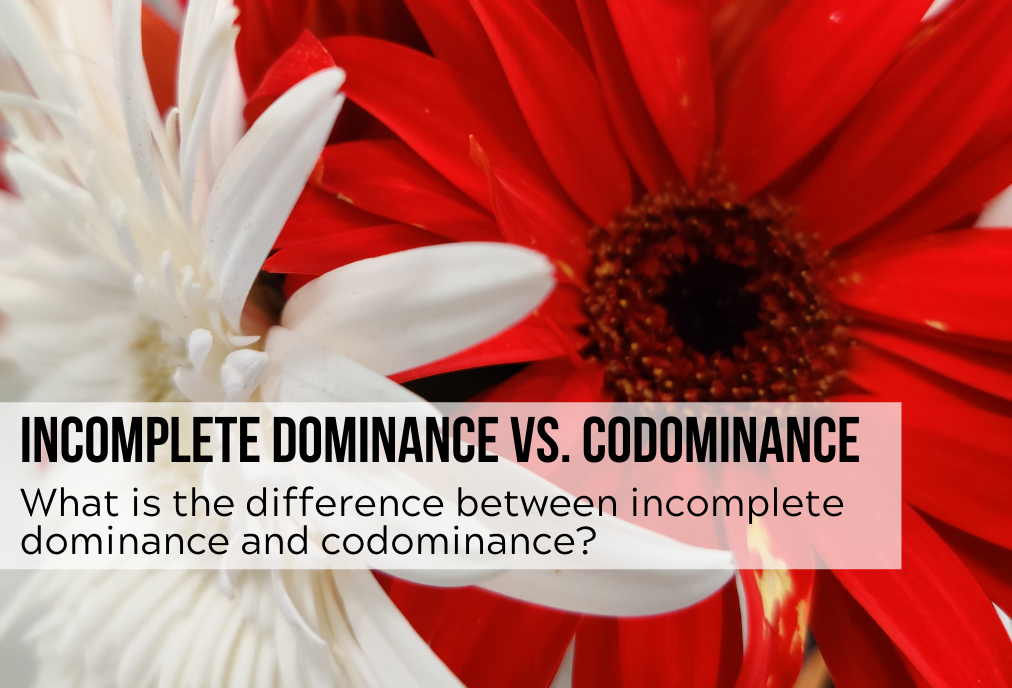
It can be difficult to differentiate between incomplete dominance vs. codominance. The two are quite similar, but fortunately there are enough differences to make it easy to know the difference! Take a look at the image below, and then read on for more information.
Incomplete dominance occurs when one trait is not completely dominant over the other trait. Therefore, the weaker trait still shines through. This creates a blended appearance.
In other words, incomplete dominance is when one allele is not completely dominant over the other. This means that the offspring’s phenotype will be different than both of their parents. Rather than completely resembling one parent or the other (as in traditional Mendelian genetics), the offspring will have a blended look.
Take a look at the image above. In this instance, a red flower and a white flower are the parents of a baby pink flower. Neither the dad’s red color, nor the mom’s white color was able to overpower the other trait. Instead, the red and the white blend together, which results in the pink color seen in the offspring.
Where can I see it? In humans, incomplete dominance is common. Our traits like height, hair color, and skin color are rarely representative of just one parent, but rather we represent a blend of both of our parents.
Codominance occurs when both traits are fully expressed. This usually results in a spotted or speckled pattern in the offspring. The prefix “co-” can help you remember this, because “co-” means together.
In other words, codominance occurs when both alleles are simultaneously dominant. The phenotype of the offspring will express both traits.
In the image above, the two flower parents are the same. One is red and the other is white. This time, when they have their baby flower, the offspring shows both of the parents’ traits. The offspring is both red and white.
The difference between incomplete dominance vs codominance is subtle. First, incomplete dominance results in two traits blending together. The offspring are a mixture of their two parents.
On the other hand, codominance results in two traits being expressed at the same time. The offspring are spotted or speckled, and fully show both traits side by side.
In this example, a red parent (with the genotype AA) and a white parent (with the genotype aa) are crossed. The parents genotypes are written on the outside of the Punnett square in no particular order. Mom can be on the left or top. Dad can be on the left or top.
Take a look at the key. You’ll notice that, unlike traditional monohybrid crosses where the genotypes AA and Aa both result in the same phenotype, in this situation there is a unique phenotype related to every genotype. Therefore, the only way to express red flowers is to be homozygous dominance (AA). The only way to express pink flowers is to be heterozygous (Aa). And the only way to express white flowers is to be homozygous recessive (aa).
Because both parents are homozygous, that means the offspring (represented in the inner boxes of the Punnett square) will always inherit a red flower allele from their red parent and they will always inherit a white flower allele from their white parent. The result, as you can see, is that these two parents have a 100% (or 4/4) possibility of having a pink, heterozygous offspring. Whether they produce 1 baby flower or 20 baby flowers, their offspring will always be heterozygous (Aa) and pink (unless there is a mutation.)
In this example, a red parent (with the genotype RR) and a white parent (with the genotype WW) are crossed. This time, we use capital letters to represent both the red and the white traits because both red and white are dominant. In fact, they codominant, or dominant together.
The parents genotypes are written on the outside of the Punnett square in no particular order. Mom can be on the left or top. Dad can be on the left or top.
Take a look at the key. You’ll notice that, unlike traditional monohybrid crosses, again in this situation there is a unique phenotype related to every genotype. Therefore, the only way to express red flowers is to be homozygous with R alleles (RR). The only way to express pink flowers is to be heterozygous (RW). And the only way to express white flowers is to be homozygous with W alleles (WW).
Because both parents are homozygous, that means the offspring (represented in the inner boxes of the Punnett square) will always inherit a red flower allele from their red parent and they will always inherit a white flower allele from their white parent. The result, as you can see, is that these two parents have a 100% (or 4/4) possibility of having a red and white speckled, heterozygous offspring. Whether they produce 1 baby flower or 20 baby flowers, their offspring will always be heterozygous (RW) and red and white speckled (unless there is a mutation.)
Practice: Now that you’ve learned the difference between incomplete dominance and codominance, it’s time to try it on your own! This 5 page worksheet will give you all the practice you need to master incomplete dominance vs codominance. The product includes an answer key so you can be sure your work is correct, and a digital version in case you prefer to work online.
Next, sign up for my newsletter to receive more science resources directly to your inbox! I will never spam you, and you’re guaranteed free resources every month! I’m just a regular teacher who enjoys helping other teachers teach and students learn.
And finally, if this blog post was helpful to you, please comment below and let me know what grade you’re in or how many years you’ve been teaching!